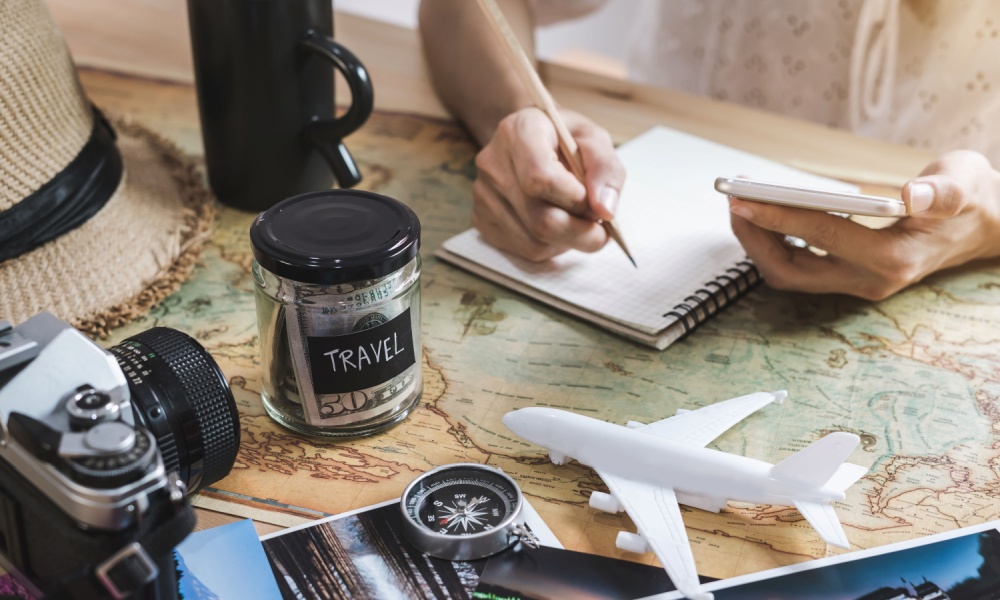For those with an interest in travel and a desire to experience the beauty of the world firsthand, planning a vacation is one of the most exciting things to do. More than just stuffing clothes in your bag and getting another stamp in your passport, vacations are experiences to fully embrace the culture and traditions of a destination as you make new memories and enjoy a breadth of experiences that are just unavailable to you in your everyday life.
Of course, as you go about researching your destination and planning your itinerary, it’s easy to get lost in the multitude of things that you need to do to make your trip a success. But following a well-organized approach to vacation planning can ensure that your trip is an adventure for the ages and not a stressful combination of missed opportunities. That’s when the vacation ideation comes into play!
Before you set out on your trip, follow these simple steps to streamline your planning process.
Inspiration Gathering

Understanding what you want to get out of your vacation is one of the most important steps in finding the destination that is right for you. Before picking the place you want to go to, ask yourself what you hope to get out of your trip. Are you just looking for a place with a nice beach to kick back and relax or do you want to fully immerse yourself in the culture of a destination by checking out local art and eating amazing cuisine?
Before deciding on where to go, immerse yourself in a variety of resources to inspire your choice. Social media apps like Instagram and Pinterest are fantastic for getting a visual feel of any destination. Travel blogs and magazines offer the chance to follow in the footsteps of experienced travelers, providing insights into what you can do and see. Interactive maps on travel websites are also invaluable, allowing you to explore both famous attractions and hidden gems. Delve into online travel forums for real-world advice and experiences from a community of travelers.
Listening to travel podcasts can give you a new perspective on destinations, sharing stories and tips from hosts and guests who have been there. YouTube travel channels are another great resource, offering a personal and dynamic view of different places, including everyday experiences and practical tips. Virtual tours can bring distant destinations right into your living room, perfect for exploring museums, historical sites, and parks remotely. Additionally, drawing inspiration from locations featured in your favorite movies, TV shows, or novels can lead to exciting travel ideas, connecting you with places that have sparked your imagination in stories.
Budget Planning

Once you’ve figured out what you’re looking for in a vacation, narrowing down your budget will definitely help you make the most of your time abroad. While airfare and hotel accommodations are often the most expensive parts of your trip, there are many other expenses that you should also take into account before heading out. Meals, public transportation, and the cost of tours and other activities that you want to enjoy are just but a few examples.
To manage these expenses effectively, consider using apps like Mint, which offer a comprehensive view of your finances by syncing with your bank accounts and categorizing your spending. For those looking for a straightforward tool to track travel-specific expenses, Trail Wallet is an excellent choice, allowing you to set daily budgets and monitor expenditures by category. Alternatively, Goodbudget, based on the envelope budgeting system, can help allocate funds for different aspects of your trip like food, accommodations, and activities.
Timing and Seasonality
Before booking your flight and hotel, be sure to fully research your destination to determine the best time of year for your visit. In this regard, it is important to make yourself aware of not only weather conditions but also peak tourist season. Visiting a destination at its peak of popularity comes with the disadvantages of large crowds and high prices. Off-peak months, on the other hand, are less crowded but often come with the trade-off of less than ideal weather conditions. Shoulder season — that is, that time of the year between peak and off-peak seasons — is a good option for those looking to enjoy the savings that come from visiting a destination during the off-season while still enjoying favorable weather.
Globetrotters hoping to immerse themselves in the culture of their destination should also keep an eye on festivals and events that are important touchstones to local residents. Oktoberfest, for example, is one of the most well-known festivals in Germany but can only be experienced in the fall.
Accommodation Options

Choosing your accommodations boils down to several factors, including how you intend to spend your trip, your budget, and its proximity to places you want to visit. If you plan to spend most of your time in a big resort, springing for better hotel accommodations will make your trip all the more enjoyable. Along with full-service amenities, most resort hotels are near major tourist hotspots, making it easy for you to do what you want and then return to your room. One great app for this is HotelTonight, which specializes in offering discounted hotel rooms for travelers looking to book on short notice.
Those who see their accommodations as just a place to sleep should consider simpler lodgings like hostels. While hostels don’t boast as many amenities as full-service hotels, they are nevertheless perfect for budget-conscious travelers hoping to spend most of their vacation touring major landmarks. To find hostels where you’re headed, Hostelworld is an app that can help. This app caters to budget-conscious travelers and those eager to meet fellow tourists.
Travelers hoping for an extended stay in their destination can benefit from a short-term rental. In addition to helping you save some money, most short-term rentals have onsite kitchens, allowing you to further save money by cooking your own meals instead of eating at expensive restaurants. The app FlipKey offers a diverse range of properties, from apartments to entire homes.
You May Also Like: Building Your Travel Fund: How to Save Up for a Vacation
Itinerary Planning

After you’ve done your research, it’s time to start planning your itinerary. Most travel experts suggest that you balance all the exciting things you want to do and see with moments of free time. Although planning an hour-by-hour schedule for your trip might seem like the logical way to make sure that you see everything you want, leaving free moments here and there gives you time to relax and prepare yourself for your next adventure on your excursion abroad.
To streamline your itinerary planning, a variety of tools, apps, and websites are at your disposal. TripIt excels in organizing travel details, creating a master itinerary from your confirmation emails. For road trip enthusiasts, Roadtrippers assists in mapping routes and discovering intriguing stops. Google Travel offers day plans tailored to your interests and time constraints, and for a visual approach, Sygic Travel Maps allows you to plot your activities on a map. Visit a City provides pre-planned itineraries for over 300 cities, adaptable to your needs. For local insights, Spotted by Locals and Like A Local present recommendations from residents, unveiling hidden gems.
FAQs:
Q: What are some tips for finding affordable transportation options during my vacation?
A: Look into local public transportation systems, consider ridesharing or carpooling services, and explore bike rental options for eco-friendly and budget-friendly travel.
Q: How can I be safe while traveling to a new destination?
A: Research the safety reputation of your destination, register with your embassy or consulate, purchase travel insurance, steer clear of shady neighborhoods, and always keep emergency contacts and important documents easily accessible.
Q: What are some strategies for navigating language barriers while traveling?
A: Learn some basic phrases in the local language, download translation apps or pocket dictionaries, seek out English-speaking locals or tour guides, and use gestures or visual aids to communicate effectively.
Q: How can I avoid overpacking for my trip?
A: Make a packing list and stick to it. Choose versatile clothing items that can be mixed and matched, pack travel-sized toiletries (or buy essentials upon arrival) and consider doing laundry during your trip to minimize the amount of clothing needed.
Q: What should I do if I encounter unexpected setbacks or changes to my travel plans?
A: The key here is to stay calm and flexible. Have a contingency plan in place, communicate with travel providers or accommodations regarding changes, and be prepared to adjust your itinerary or make alternative arrangements as needed. Everything will be ok, you’ll see.
Q: What are some ways to stay connected with your loved ones back home while traveling?
A: Purchase a local SIM card or international roaming plan for your phone and use messaging apps or social media to stay in touch for free. Of course, consider using video calls for a more personal connection, and schedule regular check-ins with family and friends to be in touch.
Do you have any other tips to nail vacation ideation? Let us know in our comments section below!


Leave a Reply